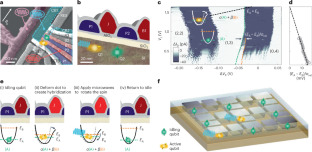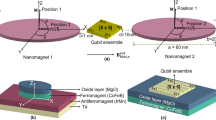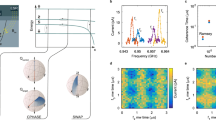Abstract
Once called a ‘classically non-describable two-valuedness’ by Pauli, the electron spin forms a qubit that is naturally robust to electric fluctuations. Paradoxically, a common control strategy is the integration of micromagnets to enhance the coupling between spins and electric fields, which, in turn, hampers noise immunity and adds architectural complexity. Here we exploit a switchable interaction between spins and orbital motion of electrons in silicon quantum dots, without a micromagnet. The weak effects of relativistic spin–orbit interaction in silicon are enhanced, leading to a speed up in Rabi frequency by a factor of up to 650 by controlling the energy quantization of electrons in the nanostructure. Fast electrical control is demonstrated in multiple devices and electronic configurations. Using the electrical drive, we achieve a coherence time T2,Hahn ≈ 50 μs, fast single-qubit gates with Tπ/2 = 3 ns and gate fidelities of 99.93%, probed by randomized benchmarking. High-performance all-electrical control improves the prospects for scalable silicon quantum computing.
This is a preview of subscription content, access via your institution
Access options
Access Nature and 54 other Nature Portfolio journals
Get Nature+, our best-value online-access subscription
$29.99 / 30 days
cancel any time
Subscribe to this journal
Receive 12 print issues and online access
$259.00 per year
only $21.58 per issue
Buy this article
- Purchase on Springer Link
- Instant access to full article PDF
Prices may be subject to local taxes which are calculated during checkout




Similar content being viewed by others
Data availability
The datasets used in this study are available via Zenodo at https://doi.org/10.5281/zenodo.7223114.
Code availability
The analysis codes that support the findings of the study are available from the corresponding authors on reasonable request.
References
Gonzalez-Zalba, M. F. et al. Scaling silicon-based quantum computing using CMOS technology. Nat. Electron. 4, 872–884 (2021).
Pioro-Ladrière, M. et al. Electrically driven single-electron spin resonance in a slanting Zeeman field. Nat. Phys. 4, 776–779 (2008).
Leon, R. C. C. et al. Coherent spin control of s-, p-, d- and f-electrons in a silicon quantum dot. Nat. Commun. 11, 797 (2020).
Koppens, F. H. L. et al. Driven coherent oscillations of a single electron spin in a quantum dot. Nature 442, 766–771 (2006).
Nadj-Perge, S., Frolov, S. M., Bakkers, E. Pa. M. & Kouwenhoven, L. P. Spin–orbit qubit in a semiconductor nanowire. Nature 468, 1084–1087 (2010).
Maurand, R. et al. A CMOS silicon spin qubit. Nat. Commun. 7, 13575 (2016).
Watzinger, H. et al. A germanium hole spin qubit. Nat. Commun. 9, 3902 (2018).
Scappucci, G. et al. The germanium quantum information route. Nat. Rev. Mater. 6, 926–943 (2021).
Froning, F. N. M. et al. Ultrafast hole spin qubit with gate-tunable spin–orbit switch functionality. Nat. Nanotechnol. 16, 308–312 (2021).
Kim, D. et al. High-fidelity resonant gating of a silicon-based quantum dot hybrid qubit. npj Quantum Inf. 1, 15004 (2015).
Benito, M. et al. Electric-field control and noise protection of the flopping-mode spin qubit. Phys. Rev. B 100, 125430 (2019).
Croot, X. et al. Flopping-mode electric dipole spin resonance. Phys. Rev. Res. 2, 012006 (2020).
Bosco, S., Benito, M., Adelsberger, C. & Loss, D. Squeezed hole spin qubits in Ge quantum dots with ultrafast gates at low power. Phys. Rev. B 104, 115425 (2021).
Kha, A., Joynt, R. & Culcer, D. Do micromagnets expose spin qubits to charge and Johnson noise? Appl. Phys. Lett. 107, 172101 (2015).
IEEE International Roadmap for Devices and Systems—IEEE IRDS; https://irds.ieee.org/
Leon, R. C. C. et al. Bell-state tomography in a silicon many-electron artificial molecule. Nat. Commun. 12, 3228 (2021).
Boter, J. M. et al. Spiderweb array: a sparse spin-qubit array. Phys. Rev. Applied 18, 024053 (2022).
Li, R. et al. A crossbar network for silicon quantum dot qubits. Sci. Adv. 4, eaar3960 (2018).
Yang, C. H. et al. Silicon qubit fidelities approaching incoherent noise limits via pulse engineering. Nat. Electron. 2, 151–158 (2019).
Seedhouse, A. E. et al. Pauli blockade in silicon quantum dots with spin-orbit control. PRX Quantum 2, 010303 (2021).
Hao, X., Ruskov, R., Xiao, M., Tahan, C. & Jiang, H. Electron spin resonance and spin–valley physics in a silicon double quantum dot. Nat. Commun. 5, 3860 (2014).
Bourdet, L. & Niquet, Y.-M. All-electrical manipulation of silicon spin qubits with tunable spin-valley mixing. Phys. Rev. B 97, 155433 (2018).
Corna, A. et al. Electrically driven electron spin resonance mediated by spin–valley–orbit coupling in a silicon quantum dot. npj Quantum Inf. 4, 6 (2018).
Huang, W., Veldhorst, M., Zimmerman, N. M., Dzurak, A. S. & Culcer, D. Electrically driven spin qubit based on valley mixing. Phys. Rev. B 95, 075403 (2017).
Huang, P. & Hu, X. Fast spin-valley-based quantum gates in Si with micromagnets. npj Quantum Inf. 7, 162 (2021).
Kyriakidis, J. & Burkard, G. Universal quantum computing with correlated spin-charge states. Phys. Rev. B 75, 115324 (2007).
Ercan, H. E., Coppersmith, S. N. & Friesen, M. Strong electron-electron interactions in Si/SiGe quantum dots. Phys. Rev. B 104, 235302 (2021).
Abadillo-Uriel, J. C., Martinez, B., Filippone, M. & Niquet, Y.-M. Two-body Wigner molecularization in asymmetric quantum dot spin qubits. Phys. Rev. B 104, 195305 (2021).
Dehollain, J. P. et al. Nanoscale broadband transmission lines for spin qubit control. Nanotechnology 24, 015202 (2012).
Fowler, A. G., Mariantoni, M., Martinis, J. M. & Cleland, A. N. Surface codes: towards practical large-scale quantum computation. Phys. Rev. A 86, 032324 (2012).
Nielsen, E. et al. Gate set tomography. Quantum 5, 557 (2021).
Noiri, A. et al. Fast universal quantum gate above the fault-tolerance threshold in silicon. Nature 601, 338–342 (2022).
Xue, X. et al. Quantum logic with spin qubits crossing the surface code threshold. Nature 601, 343–347 (2022).
Mills, A. R. et al. Two-qubit silicon quantum processor with operation fidelity exceeding 99%. Sci. Adv. 8, eabn5130 (2022).
Yao, W., Liu, R.-B. & Sham, L. J. Theory of control of the spin-photon interface for quantum networks. Phys. Rev. Lett. 95, 030504 (2005).
Mi, X. et al. A coherent spin–photon interface in silicon. Nature 555, 599–603 (2018).
Jaksch, D. et al. Fast quantum gates for neutral atoms. Phys. Rev. Lett. 85, 2208–2211 (2000).
Crane, E., Schuckert, A., Le, N. H. & Fisher, A. J. Rydberg entangling gates in silicon. Phys. Rev. Res. 3, 033086 (2021).
Sørensen, A. & Mølmer, K. Quantum computation with ions in thermal motion. Phys. Rev. Lett. 82, 1971–1974 (1999).
Tosi, G. et al. Silicon quantum processor with robust long-distance qubit couplings. Nat. Commun. 8, 450 (2017).
Yang, C. H., Lim, W. H., Zwanenburg, F. A. & Dzurak, A. S. Dynamically controlled charge sensing of a few-electron silicon quantum dot. AIP Advances 1, 042111 (2011).
Ono, K., Austing, D. G., Tokura, Y. & Tarucha, S. Current rectification by Pauli exclusion in a weakly coupled double quantum dot system. Science 297, 1313–1317 (2002).
Yang, C. H. et al. Orbital and valley state spectra of a few-electron silicon quantum dot. Phys. Rev. B 86, 115319 (2012).
Becker, P., Pohl, H.-J., Riemann, H. & Abrosimov, N. Enrichment of silicon for a better kilogram. Phys. Status Solidi 207, 49–66 (2010).
Itoh, K. M. & Watanabe, H. Isotope engineering of silicon and diamond for quantum computing and sensing applications. MRS Commun. 4, 143–157 (2014).
Acknowledgements
We acknowledge helpful conversations and technical support from A. Dickie. We acknowledge support from the Australian Research Council (FL190100167 and CE170100012), the US Army Research Office (W911NF-17-1-0198) and the NSW Node of the Australian National Fabrication Facility. The views and conclusions contained in this document are those of the authors and should not be interpreted as representing the official policies, either expressed or implied, of the Army Research Office or the US Government. The US Government is authorized to reproduce and distribute reprints for Government purposes notwithstanding any copyright notation herein. W.G., M.F., J.Y.H., J.D.C. and S.S. acknowledge support from Sydney Quantum Academy.
Author information
Authors and Affiliations
Contributions
T.T. measured devices A and C and observing the enhanced silicon-on-insulator Rabi first in device A. W.G. measured devices B and D, demonstrating EDSR without a micromagnet in device D. J.Y.H. participated in qubit benchmarking in device D, with M.F. and W.G. participating in the analysis. W.H.L. participated in the measurements with all the devices. Experiments were done under the supervision of A.L., A.S., A.S.D. and C.H.Y. W.H.L. and F.E.H. fabricated the devices, under the supervision of A.S.D., on enriched 28Si wafers supplied by K.M.I., N.V.A., H.-J.P. and M.L.W.T. S.S. designed the radio-frequency setup for devices B and D. A.S., C.H.Y. and R.C.C.L. developed the control strategies for enhanced EDSR. P.Y.M., M.F. and J.D.C. developed the models of spin–orbital degeneracy, under the supervision of A.S. and C.E. W.G., A.S., M.F., T.T., W.H.L., J.Y.H., F.E.H., A.L., C.H.Y., A.M. and A.S.D. wrote the manuscript, with input from all the co-authors.
Corresponding authors
Ethics declarations
Competing interests
T.T., W.H.L., R.C.C.L., A.L., C.H.Y., A.S. and A.S.D. are inventors on a patent related to this work (AU provisional application 2021901923) filed by the University of New South Wales with a priority date of 25 June 2021. A.S.D. is the CEO and Director of Diraq Pty Ltd.
Peer review
Peer review information
Nature Nanotechnology thanks Xuedong Hu, Dominik Zumbuhl and the other, anonymous, reviewer(s) for their contribution to the peer review of this work.
Additional information
Publisher’s note Springer Nature remains neutral with regard to jurisdictional claims in published maps and institutional affiliations.
Extended data
Extended Data Fig. 1 Obtaining degeneracy on demand via excited state spectroscopy.
This is a protocol for tuning the energy spectrum of a new charge configuration to create a level degeneracy, resulting in a speed-up of the qubit Rabi frequency. The protocol utilises tunnel-rate-based excited state spectroscopy (see Methods). The voltage detuning between dots, ΔVP, is swept across an interdot charge transition to observe changes in the interdot tunnel rate associated with the resonant tunneling into excited states [43]. a, Top-view schematic layout of the device gates. b, Excited state spectroscopy where Voffset is stepped. The two right-most features are designated as states A and B, representing the ground and first excited states of the P1 dot, which we observe to be converging for decreasing Voffset. The relevant gate voltages are shown in the table. In c, VJ is swept to re-adjust the interdot tunnel rate so that the excited state transition is visible at the probe frequency of 477 Hz. In d, we again try to measure movement in the excited state energy, this time at a lower Voffset. In e we sweep VJ to adjust the tunnel rate, and to get an indication of the effect on the excited state energy. We observe that the excited state energy appears to be decreasing for increasing VJ. Finally, we take a PESOS map in this configuration, and observe a speed up of the Rabi frequency at the location of the red triangle marked in e. This PESOS map is shown in main text Fig. 2b.
Extended Data Fig. 3 Variation of a degeneracy with applied magnetic field.
a-h, PESOS maps taken at various values of B0 field in Device D, with a (1,1) charge configuration, indicating that the characteristic of a degeneracy point may be tuned. Techniques using gate-bias voltages (such as in Ext Data Fig. 1) may prove more scalable however, and are an avenue for future research.
Extended Data Fig. 4 PESOS and Rabi oscillations at the high-fidelity point.
a, PESOS map acquired with microwave drive applied to the CB1 gate. b, A PESOS map acquired using the same configuration as for Fig. 4, with microwave drive applied to the J-gate. Both a and b use the same source power of 20 dBm, however variation in line losses due to different electronics may result in differences in electric field amplitude applied to the CB1- and J-gates. c, Rabi oscillations in the same configuration as Fig. 4a,b with an oscillation frequency of fRabi = 4.6 MHz, and a quality factor of 58.
Extended Data Fig. 5 Slow rabi oscillation.
a, PESOS map taken for a large range in VJ in the same configuration as Fig. 3a,b. The microwave burst is applied for 8μs. b, Rabi oscillation taken at VJ = 1.642 V, with the same power as the fast Rabi oscillation in Fig. 3b. A fitted decaying sinusoid gives fRabi = 124 kHz. It can be seen that the resonance vanishes in a at higher VJ, indicating that spin-orbit coupling and driving efficiency continue to decrease past the point at which coherent oscillations can be measured.
Extended Data Fig. 6 Pulse sequences and additional data for coherence and switchability measurements.
a, Altered Ramsey pulse sequence used for Fig. 4c in which during the wait time Twait a bias ΔVJ is applied to J. b, Coherent Ramsey oscillations for the sequence in a, and processed to produce Fig. 4c. A virtual phase is added to the second X/2 pulse to aid data processing and fitting. c, Altered Hahn echo pulse sequence with offset wait times (as in a) used for Fig. 4c. d, Measured data for the pulse sequence in c, and processed to produce the data in Fig. 4c. e, Coherent switching pulse sequence. The qubit is switched Ncycles times between two bias points Δ1 and Δ2, being close to and far from the degeneracy point respectively. A virtual Z-phase is added before the final X/2 pulse. In addition to this, a variable time Twait is added in order to keep the total time between the two X/2 pulses the same for all values of Ncycles. The wait time is only added in the off-state, Δ2. Each switching cycle uses 20 ns on/off ramps, with a 20 ns pulse settling time at each level. f, Measured data using the pulse sequence in e, with Twait = 30 μs. This data is used to calculate the return amplitudes for sequence e in h, also shown in Fig. 4d. g, Coherence switching pulse sequence in which the amount of time spent in each of the states Δ1 and Δ2 is kept constant in order to cancel out the effect of fast decoherence near the degeneracy from the switching fidelity calculation. h, Measurement of the return amplitudes for varying Ncycles for sequences e with Twait = 30 μs (also shown in Fig. 4d), and g with Twait = 4, 8 μs. We see that for sequence g the baseline return amplitude is reduced, due to the short coherence time at the Δ1 point, however there is no observable coherence decay associated with increasing Ncycles.
Extended Data Fig. 7 Calibration of the microwave excitation amplitude.
The microwave signal applied to the CB1 gate of Device D is delivered through a transmission line that is poorly characterised for frequencies above 6 GHz. a, Here the line transmission is calibrated by first measuring the slope of Coulomb oscillations relative to the voltages on the sensor top gate and the CB1 gate, which gives a relative lever arm of 14.8. Then, in b the width of a single Coulomb peak is measured against the microwave amplitude, scaled from a reference level of 0 dBm from the source. The fitted peak width trend in c gives a maximum amplitude at the CB1 gate of 50 ± 2 mV when multiplied by the relative lever arm. Due to the possibility for a Coulomb peak to also be broadened by local heating effects, or microwave induced charge traps, this calculated amplitude represents an upper bound.
Extended Data Fig. 8 Enhanced relaxation rate near level degeneracy.
The spin relaxation time T1 measuring across the full target charge configurations for Device A (a) and Device D (b) in VJ and ΔVP gate space. The locations of level crossings are indicated as red dashed lines. This shows an enhanced spin relaxation rate near the point of level degeneracy in the respective systems. Interestingly, there are two visible transitions in Device D, between which the spin relaxation is faster than the background, potentially indicating the population of an alternative ground state.
Extended Data Fig. 9 Diabatic orbital excitation.
a, PESOS map in which the ramp time of the J-gate voltage is 80 ns. The resonance frequency continues on a linear trend, indicating that the orbital state is maintained when crossing the point of degeneracy at VJ = 1.638 V. b, PESOS map in which the J-gate ramp time is increased to 2 μs. The resonance frequency jumps after the degeneracy point, indicating population of a new orbital state via adiabatic passage across the level-crossing.
Extended Data Fig. 10 Rabi frequency compensation.
a and b show Rabi oscillations discretised into π/2 rotations and repeated 10 times to observe instability, with Rabi frequency feedback on, and off, respectively. The feedback protocol measures Pflip for 5, 7, 9, and 11 π/2 pulses, each of which should result in a 0.5 flip proportion in the ideal case. It then applies a correction to the microwave amplitude of δAMW = -gain * [P5 − P7 + P9 − P11], where Pn is the measured spin flip proportion after n π/2 rotations.
Supplementary information
Supplementary Information
Supplementary Sections A–F, Figs. 1 and 2 and Table 1.
Rights and permissions
Springer Nature or its licensor (e.g. a society or other partner) holds exclusive rights to this article under a publishing agreement with the author(s) or other rightsholder(s); author self-archiving of the accepted manuscript version of this article is solely governed by the terms of such publishing agreement and applicable law.
About this article
Cite this article
Gilbert, W., Tanttu, T., Lim, W.H. et al. On-demand electrical control of spin qubits. Nat. Nanotechnol. 18, 131–136 (2023). https://doi.org/10.1038/s41565-022-01280-4
Received:
Accepted:
Published:
Issue Date:
DOI: https://doi.org/10.1038/s41565-022-01280-4
This article is cited by
-
Non-symmetric Pauli spin blockade in a silicon double quantum dot
npj Quantum Information (2024)
-
High-fidelity spin qubit operation and algorithmic initialization above 1 K
Nature (2024)
-
Electric field-tuneable crossing of hole Zeeman splitting and orbital gaps in compressively strained germanium semiconductor on silicon
Communications Materials (2023)
-
Highly tunable ultrafast control of a spin qubit
Nature Nanotechnology (2023)



